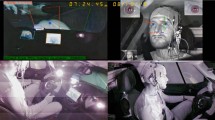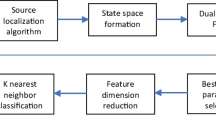Abstract
We developed an EEG-based probabilistic model, which effectively predicts drowsiness levels of thirty-two subjects involved in a moving base driving simulator experiment. A hierarchical Gaussian mixture model (hGMM) with two mixture components at the lower hierarchical level is used. Each mixture models data density distribution of one of the two drowsiness cornerstones/classes represented by 4-second long EEG segments with low and high drowsiness levels. We transfer spectral contents of each EEG segment into a compact form of autoregressive model coefficients. The Karolinska drowsiness scoring method is used to initially label data belonging to individual classes. We demonstrate good agreement between Karolinska drowsiness scores and the predicted drowsiness, when the hGMM is applied to continuously monitor drowsiness over the time-course of driving sessions. The computations associated with the approach are fast enough to build up a practical real-time drowsiness monitoring system.
Chapter PDF
Similar content being viewed by others
Keywords
- Gaussian Mixture Model
- Correct Classification Rate
- Driving Simulator
- Lower Hierarchical Level
- Simulated Road
These keywords were added by machine and not by the authors. This process is experimental and the keywords may be updated as the learning algorithm improves.
References
Bishop, C.: Pattern Recognition and Machine Learning. Springer, Heidelberg (2006)
Dempster, A.P., Laird, N.M., Rubin, D.B.: Maximum likelihood from incomplete data via the EM algorithm. J. Royal Stat. Soc. B 39, 1–38 (1977)
Gillberg, M., Kecklund, G., Åkerstedt, T.: Sleep and performance of professional drivers in a truck simulator - comparison between day and night driving. J. of Sleep Res. 5, 12–15 (1996)
Fraley, C., Raftery, A.E.: Model-Based Clustering, Discriminant Analysis, and Density Estimation. J. Am. Stat. Assoc. 97, 611–631 (2002)
Hastie, T., Tibshirani, R.: Discriminant Analysis by Gaussian Mixtures. J. Royal Stat. Soc. B 58, 155–176 (1996)
Heckman, N., Zamar, R.: Comparing the shapes of regression functions. Biometrika 87, 135–144 (2000)
McLachlan, G.L., Peel, D.: Finite Mixture Models. John Wiley & Sons, New York (2000)
Nabney, I.T.: NETLAB: Algorithms for Pattern Recognition. Springer, Heidelberg (2004)
Rechtschaffen, A., Kales, A.: A manual of Standardized Technology, Techniques, and Scoring Systems for Sleep Stages of Human Subjects. Technical Report, Brain Research Institute UCLA, Los Angeles (1968)
Rosipal, R., Neubauer, S., Anderer, P., Gruber, G., Parapatics, S., Woertz, M., Dorffner, G.: A continuous probabilistic approach to sleep and daytime sleepiness modeling. ESRS2006, P299, Innsbruck (September 2006)
Santamaria, J., Chiappa, K.H.: The EEG of Drowsiness. Demos Medical Publishing (1987)
Törnros, J.: Driving behaviour in a real and simulated road tunnel — a validation study. Accident Analysis & Prevent 4, 497–503 (1998)
Author information
Authors and Affiliations
Editor information
Rights and permissions
Copyright information
© 2007 Springer-Verlag Berlin Heidelberg
About this paper
Cite this paper
Rosipal, R. et al. (2007). EEG-Based Drivers’ Drowsiness Monitoring Using a Hierarchical Gaussian Mixture Model. In: Schmorrow, D.D., Reeves, L.M. (eds) Foundations of Augmented Cognition. FAC 2007. Lecture Notes in Computer Science(), vol 4565. Springer, Berlin, Heidelberg. https://doi.org/10.1007/978-3-540-73216-7_33
Download citation
DOI: https://doi.org/10.1007/978-3-540-73216-7_33
Publisher Name: Springer, Berlin, Heidelberg
Print ISBN: 978-3-540-73215-0
Online ISBN: 978-3-540-73216-7
eBook Packages: Computer ScienceComputer Science (R0)





